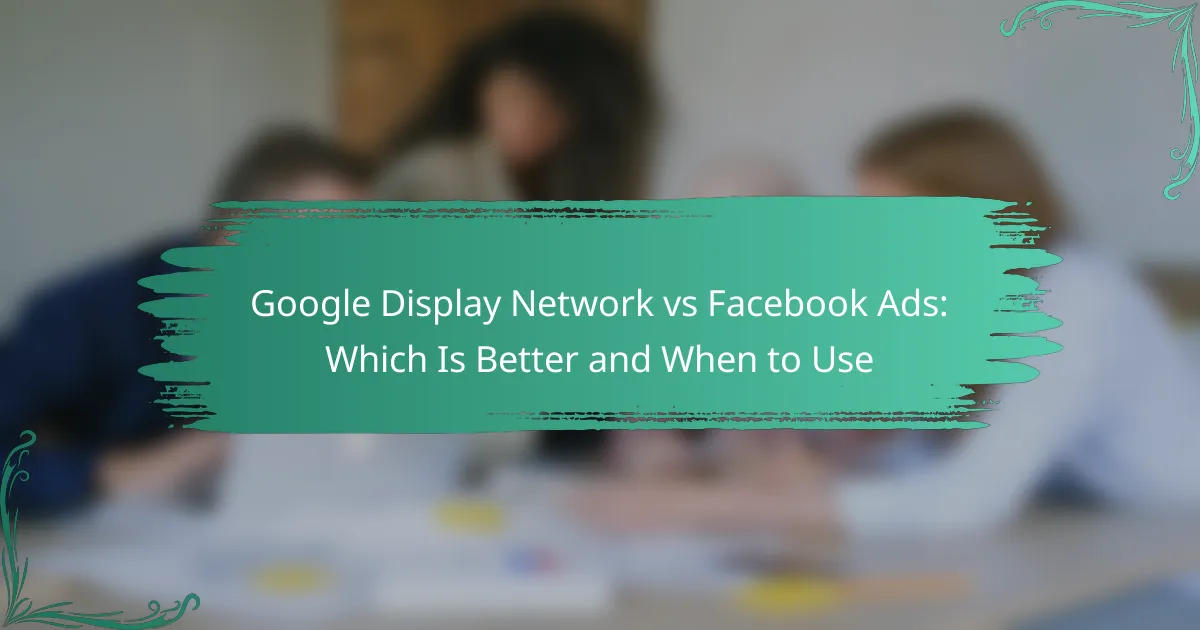When choosing between Google Display Network (GDN) and Facebook Ads, it’s essential to consider your advertising goals and target audience. GDN is best for broad reach and brand visibility, while Facebook Ads offer precise targeting for specific audience segments, making them ideal for engagement-focused campaigns.
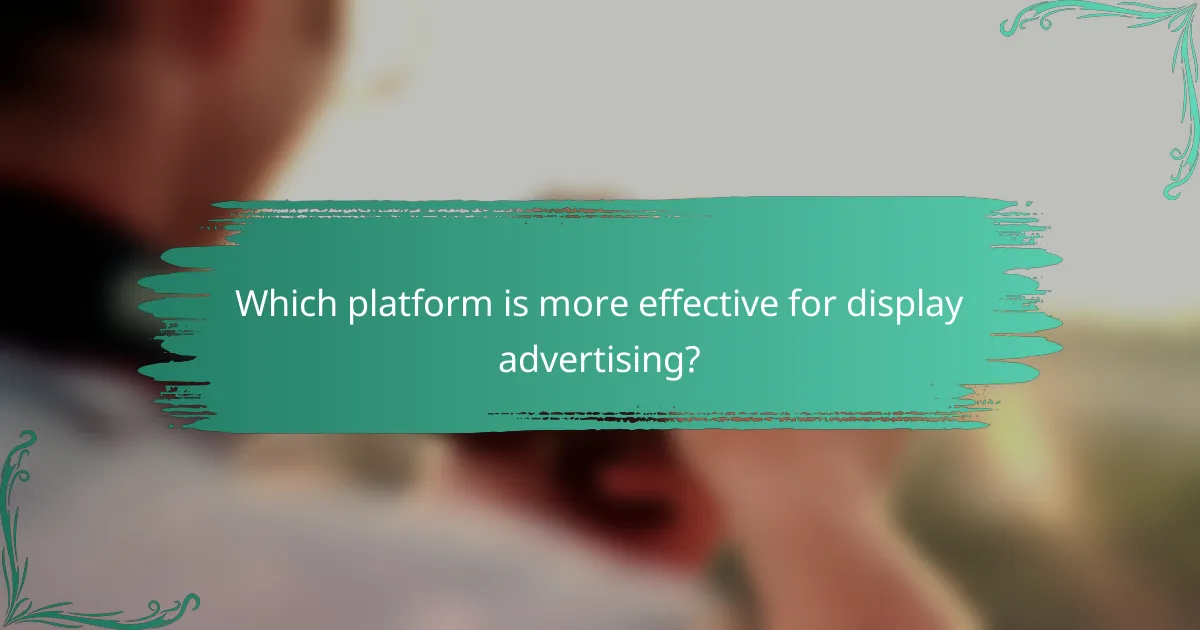
Which platform is more effective for display advertising?
Determining the effectiveness of Google Display Network (GDN) versus Facebook Ads for display advertising depends on your specific goals and audience. GDN excels in reach, while Facebook offers advanced targeting capabilities.
Google Display Network offers extensive reach
The Google Display Network allows advertisers to reach a vast audience across millions of websites, apps, and videos. This extensive reach means that brands can effectively increase visibility and brand awareness on a global scale.
For example, if you’re launching a new product, GDN can help you showcase it to a broad audience, potentially reaching billions of impressions. This is particularly beneficial for campaigns focused on awareness rather than direct conversions.
Facebook Ads provide superior targeting options
Facebook Ads stand out for their advanced targeting capabilities, allowing advertisers to reach specific demographics, interests, and behaviors. This precision enables campaigns to connect with users who are more likely to engage with the content.
For instance, if you are promoting a niche product, Facebook’s ability to target users based on their interests can significantly enhance the likelihood of conversions. Advertisers can create custom audiences, lookalike audiences, and retarget users who have previously interacted with their brand.
Cost-effectiveness varies by campaign goals
The cost-effectiveness of GDN and Facebook Ads largely depends on your campaign objectives. GDN may offer lower cost-per-click (CPC) rates, making it suitable for brand awareness campaigns, while Facebook Ads can yield higher engagement rates for targeted campaigns.
When deciding between the two, consider your budget and goals. If your focus is on driving traffic to a website, GDN might be more economical. However, for generating leads or sales, the higher costs associated with Facebook Ads may be justified by their targeting effectiveness.
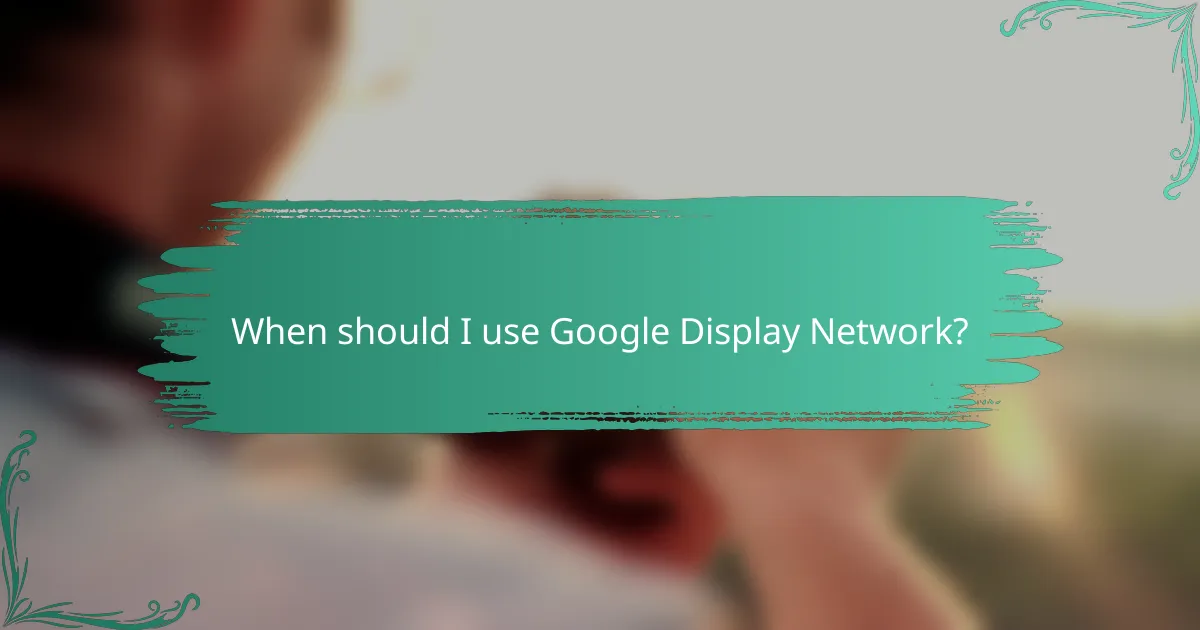
When should I use Google Display Network?
You should use the Google Display Network (GDN) when your goal is to reach a wide audience and enhance brand visibility across various websites. GDN is effective for campaigns focused on generating awareness and retargeting users who have previously interacted with your brand.
For broad audience reach and brand awareness
The Google Display Network is ideal for campaigns aiming for broad audience reach and brand awareness. With access to millions of websites, apps, and videos, GDN allows advertisers to showcase their ads to diverse demographics across the internet.
To maximize effectiveness, consider using visually engaging ad formats, such as banners or videos, which can capture attention more effectively than text ads. Aim for a mix of targeting options, including contextual targeting based on website content and demographic targeting to reach specific audience segments.
When retargeting previous website visitors
Retargeting through the Google Display Network is a powerful strategy for re-engaging users who have previously visited your website. This approach helps remind potential customers of your products or services, increasing the likelihood of conversion.
To implement effective retargeting, set up a remarketing list in Google Ads and create tailored ads that address the specific interests or behaviors of those visitors. Consider using dynamic ads that showcase products users viewed, as this personalized approach can significantly boost engagement and conversion rates.

When should I use Facebook Ads?
Facebook Ads are ideal when you want to reach specific audience segments with tailored messaging. They excel in targeting based on demographics, interests, and behaviors, making them suitable for campaigns focused on engagement and brand awareness.
For highly targeted demographic campaigns
Facebook Ads allow advertisers to create highly targeted campaigns by leveraging extensive user data. You can specify criteria such as age, gender, location, and interests to reach your desired audience effectively. For instance, a local bakery might target users aged 18-35 within a 10-mile radius who have shown interest in baking or organic foods.
Consider using Facebook’s lookalike audiences feature to find new customers similar to your existing ones. This can enhance your campaign’s effectiveness by reaching people who are more likely to convert based on their similarities to your current customer base.
To drive engagement on social media
Facebook Ads are particularly effective for driving engagement on social media platforms. They can be designed to encourage likes, shares, and comments, which can amplify your brand’s visibility. For example, a clothing brand might run a campaign featuring a new collection with a call-to-action to share their favorite outfit.
Utilizing engaging visuals and compelling copy is crucial for maximizing interaction. Additionally, consider running contests or promotions through ads to incentivize user participation and increase overall engagement rates.
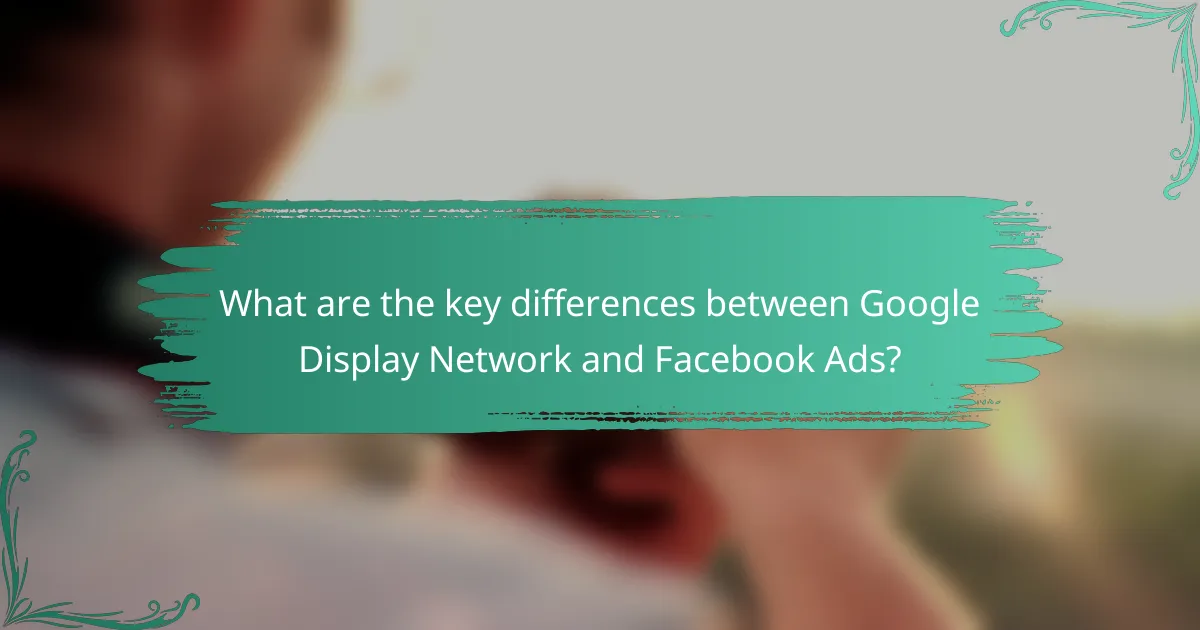
What are the key differences between Google Display Network and Facebook Ads?
The Google Display Network (GDN) and Facebook Ads serve distinct advertising purposes and operate on different platforms. GDN focuses on visual ads across a vast network of websites, while Facebook Ads leverage user data to display targeted ads within the social media platform.
Ad formats and placements differ significantly
Google Display Network offers a variety of ad formats, including banner ads, responsive ads, and video ads, which can appear on millions of websites and apps. Advertisers can choose placements based on specific criteria, such as topics or demographics, allowing for broad visibility across the internet.
In contrast, Facebook Ads primarily utilize formats like image ads, video ads, carousel ads, and slideshow ads, all designed to engage users within the Facebook ecosystem. Ads appear in users’ feeds, stories, and on Instagram, ensuring they are integrated into the social experience.
Audience targeting mechanisms vary
Google Display Network targets audiences based on keywords, topics, and demographics, allowing advertisers to reach users while they browse related content. This method is effective for capturing interest at various stages of the buying journey, particularly for users actively searching for information.
Facebook Ads, however, rely heavily on user behavior and interests, utilizing extensive data from user profiles and interactions. This enables advertisers to create highly specific audience segments, which can lead to more personalized and engaging ad experiences. For example, businesses can target users based on their likes, interests, and even life events.
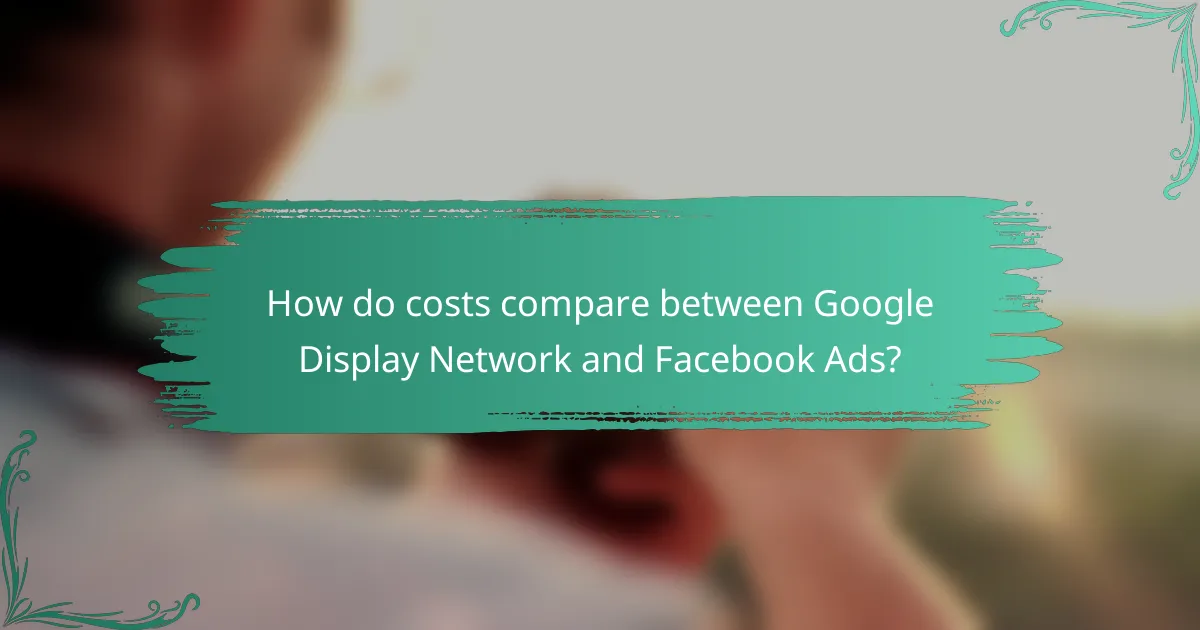
How do costs compare between Google Display Network and Facebook Ads?
The costs of advertising on the Google Display Network (GDN) and Facebook Ads vary significantly based on their pricing models. GDN typically charges advertisers per impression, while Facebook Ads often utilize a cost-per-click model, which can influence your budget and strategy depending on your campaign goals.
Google Display Network typically charges per impression
On the Google Display Network, advertisers usually pay for ad impressions, meaning they are charged each time their ad is displayed, regardless of whether users click on it. This model can lead to lower costs for campaigns focused on brand visibility, as you may pay anywhere from a few cents to a couple of dollars per thousand impressions (CPM).
When using GDN, it’s essential to consider your target audience and ad placement to maximize the effectiveness of your budget. A well-targeted campaign can yield higher engagement rates, making the cost-per-impression more worthwhile.
Facebook Ads often use a cost-per-click model
Facebook Ads primarily operate on a cost-per-click (CPC) basis, where advertisers pay only when a user clicks on their ad. This model can be advantageous for campaigns aimed at driving traffic to a website or generating leads, with CPC rates typically ranging from a few cents to several dollars, depending on competition and targeting.
Choosing the CPC model allows for more precise budget control, as you only pay for actual engagement. However, it’s crucial to create compelling ad content to ensure a higher click-through rate, which can help lower your overall advertising costs.

What metrics should I track for each platform?
When evaluating Google Display Network and Facebook Ads, focus on metrics that reflect user interactions and conversions. Key performance indicators (KPIs) like click-through rates, conversion rates, and engagement metrics will provide insights into the effectiveness of your campaigns on each platform.
Click-through rates and conversion rates
Click-through rates (CTR) measure how often people click on your ads after seeing them. For Google Display Network, a good CTR typically ranges from 0.5% to 2%, while Facebook Ads may see higher rates, often between 1% and 3%. Monitoring these rates helps you understand the appeal of your ad content.
Conversion rates indicate the percentage of users who complete a desired action, such as making a purchase or signing up for a newsletter. For Google Display, conversion rates can vary widely, often falling between 1% and 5%, depending on the industry. Facebook Ads might yield slightly better conversion rates due to its targeting capabilities, commonly ranging from 2% to 10%.
Engagement metrics on Facebook Ads
Engagement metrics on Facebook Ads include likes, shares, comments, and overall interactions with your content. These metrics are crucial for assessing how well your ads resonate with the audience. High engagement rates can indicate strong brand affinity and may lead to increased organic reach.
To effectively track engagement, consider setting benchmarks based on your industry. A typical engagement rate for Facebook Ads might range from 1% to 5%, but this can vary significantly based on the ad format and audience targeting. Regularly analyzing these metrics can help refine your ad strategy and improve overall performance.

What are the prerequisites for running effective campaigns?
To run effective campaigns on platforms like Google Display Network and Facebook Ads, you need a clear understanding of your target audience, campaign objectives, and budget. Additionally, familiarity with the tools and analytics provided by each platform is essential for optimizing performance.
Understanding your target audience
Identifying your target audience is crucial for any advertising campaign. Consider demographics such as age, gender, location, and interests to tailor your messaging effectively. Utilize tools like Facebook Audience Insights or Google Analytics to gather data about potential customers.
Defining campaign objectives
Your campaign objectives should align with your overall marketing goals. Whether you aim to increase brand awareness, drive website traffic, or generate leads, clearly defined objectives will guide your strategy. Use the SMART criteria—Specific, Measurable, Achievable, Relevant, Time-bound—to set effective goals.
Setting a budget
Establishing a budget is vital for managing your advertising spend. Determine how much you can allocate daily or monthly and consider the cost-per-click (CPC) or cost-per-impression (CPM) models of each platform. A common approach is to start with a modest budget and adjust based on performance metrics.
Familiarity with platform tools
Each advertising platform offers unique tools for campaign management and analytics. Familiarize yourself with Google Ads and Facebook Ads Manager to leverage their features effectively. Understanding how to set up tracking pixels, A/B testing, and audience segmentation can significantly enhance your campaign’s effectiveness.
